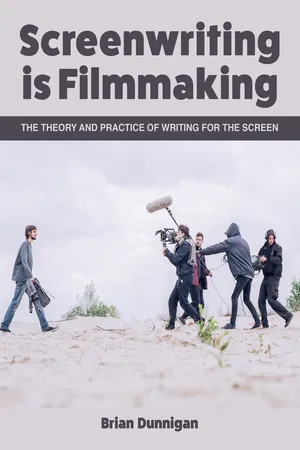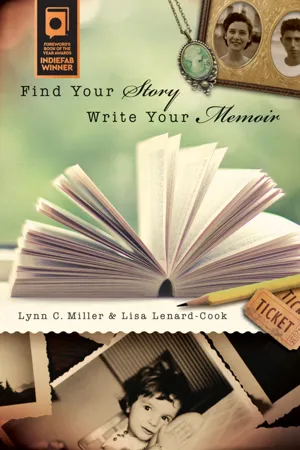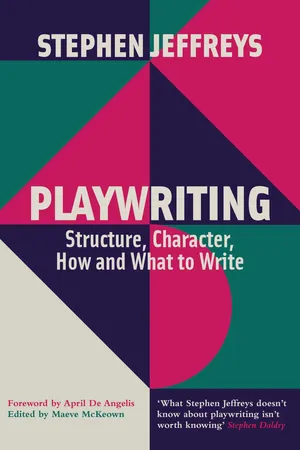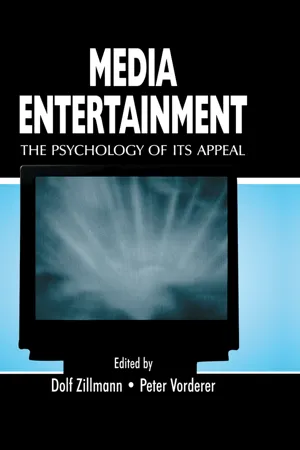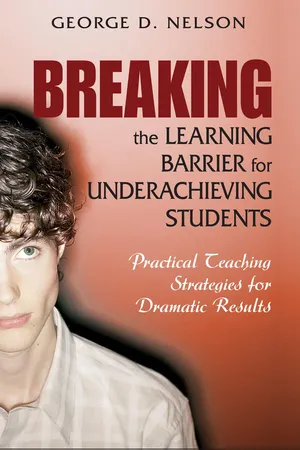Literature
Dramatic Structure
Dramatic structure refers to the organization and arrangement of events in a play or narrative. It typically consists of exposition, rising action, climax, falling action, and resolution. These elements create a framework for the development and resolution of conflicts, as well as the overall flow and impact of the story.
Written by Perlego with AI-assistance
Related key terms
1 of 5
6 Key excerpts on "Dramatic Structure"
- eBook - ePub
Screenwriting is Filmmaking
The Theory and Practice of Writing for the Screen
- Brian Dunnigan(Author)
- 2019(Publication Date)
- Crowood(Publisher)
5 STRUCTUREIt is in our nature to tell stories, to dramatize our relationships, our work, our love lives, our everyday encounters – to give them shape and meaning, to clarify and communicate to others. In dramatizing we give life a plot; we select and organize events in order to entertain and to understand what happened. For this we use dramatic tools: set-up, suspense and surprise, juxtaposition, ellipsis, irony, the compression and extension of time.Dramatic stories engage an audience, appealing to our emotions, imagination and intellect. A well-designed, well-structured script will resonate more deeply, touch and amuse us in more complex ways than a script with poor structure.Understanding structure is a way of thinking about the audience experience, about how to tell the story so as to involve the viewer. This requires getting a handle on concepts such as point of view, preparation and foreshadowing, cause and effect, exposition and revelation, as well as the role of dramatic conflict in creating momentum and surprise. Good structure is about keeping the audience involved and shares with the well-told joke a sense of rhythm and timing, including where and when to place the dramatic moments of a story for maximum effect. - eBook - PDF
- Lynn C. Miller, Lisa Lenard-Cook(Authors)
- 2013(Publication Date)
- University of Wisconsin Press(Publisher)
Dramatic Structure is your means to this end. A scene’s structure begins with an immediate entrance into what’s happening on the page by providing a protagonist with whom the reader wishes to spend time and an image that immerses the reader at once into a moment from that narrator’s life. Scene structure sets what Lisa Dale Norton calls “shimmering images” into motion. Dramatic Structure organizes both scenes and the larger work into a coherent whole that moves forward from its opening moment. Consider Penelope Lively’s scene above. The protagonist is a child, some- one who notices things like the sticky leather seat and the passing trees, and at the same time an adult who possesses the author’s resources of language and experience. Toggling between the child’s sense of the moment and her own adult capacity for transforming memory into language, Lively provides an immediate entrance into the scene and immerses the reader in the moment. To the reader, this action appears effortless. For you the writer, it’s a skill you’ll master through study and practice. The tools of scene structure allow you, the writer, to share the experience of you, the subject, with readers via telling details and emblematic moments. Scenes—the building blocks of Dramatic Structure—particularize the general, offering moving pictures of time in motion, each with a beginning, a middle, and an end, as Lively does in the scene above. Ordering the Scene No matter where it begins or ends, no matter how long it takes, no matter what happens over its course, every scene—and your larger work, because every scene is a miniplot—should contain each of the following steps in this order: catalyst → conflict → rising action → climax → denouement arranging the scenes The catalyst is the moment in time at which a scene begins to move. The conflict involves the oppositions, internal or external, facing the protagonist. The rising action deepens the oppositions the protagonist faces. - eBook - ePub
Playwriting
Structure, Character, How and What to Write
- Stephen Jeffreys(Author)
- 2019(Publication Date)
- Nick Hern Books(Publisher)
see here ), instead written like a cool television screenplay with too many scenes. You may have experienced when writing a play, that at some point it takes charge; you have lost certain options and you’re being pushed into choices that you don’t want to make. These problems usually occur because the structure is wrong.After some time learning the basics of Dramatic Structure, you should be able to choose instinctively the correct structure for a play. An exercise I often set myself is, whenever I’m sitting on a bus and I see a newspaper, I pick it up and choose a story. By the end of the bus ride, I will have worked out the structure of the play that would best tell that story. Ask yourself questions such as, ‘How would I do that story in the theatre?’, ‘What kind of play is it?’ Eventually, by habit of thought, and by using structure creatively, you can work out the shape of the play. You might not have the play perfectly worked out in ten minutes, but you will probably get ninety per cent of the story right by using the simple tools conveyed in this chapter.There is, of course, a danger of using Dramatic Structure in a formulaic and uncreative way. And so in the following pages, I will not only look at conventional Dramatic Structure, but also at experimental structures. My theory is that quite conservative-looking and old-fashioned structures can be radicalised; you can take any Dramatic Structure and do something exciting with it. But in order to do that, you have to know what the structure is doing in the first place.Theatre Events StructureA play is an event. So before analysing Dramatic Structure, it is worth discussing the shape of an evening in the theatre, as this affects the structure you choose. Of course, theatre events differ from society to society, but I want to think briefly about writing full-length plays in the theatre culture of early twenty-first-century Britain, and the changes that have occurred even in my lifetime. - eBook - ePub
Media Entertainment
The Psychology of Its Appeal
- Dolf Zillmann, Peter Vorderer(Authors)
- 2000(Publication Date)
- Routledge(Publisher)
plot is ambiguous and rich in meaning, as it refers to both the specific events (actions or happenings) presented in a drama, and to the artistic arrangement of these events in the presentation. From a literary point of view, the plot conveys a certain moral (e.g., treachery leads to disaster), and thereby evokes the audience’s emotions by a balanced and well-timed presentation of information about characters and events. In the significance of the plot, drama resembles narration. Both genres are narrative, in that they provide a representation of a series of causally and chronologically related events experienced or caused by actors (Bal, 1985; Onega & Landa García, 1996). However, they differ in their emphases on certain aspects of narration that are crucial for the audience’s emotional response. As the traditional form of narration, the novel acquires its emotional vividness by revealing the inner experiential landscape of its characters (“telling”; cf. Onega & Landa García, 1996). As Bakhtin (1963) suggested, the novel is the genre of the dialogue—not only among characters, but also (in a metaphorical sense) between characters and readers or author and reader. More recent forms of narration in this sense are telenovelas and soap operas. In contrast, drama focuses on events with clear relations between cause and effect (“showing” instead of “telling”; cf. Onega & Landa García, 1996). In short, novels tell “how it feels,” whereas drama shows “how it happens” (See for a similar distinction between “experience-texts” and “action-texts,” Cupchik & László, 1994).Given the centrality of events in drama, the definition of an event becomes crucial. Not every action in a drama counts as an event that is functional to the plot. Bal (1985) defined an event as transition from one state to another state that is caused or experienced by actors. This rather rough definition still covers actions of minor relevance and is therefore specified by the following three criteria: an event has to include a change of the situation, a choice on an actor’s behalf, and confrontation between actors or groups of actors. All of these criteria refer more or less directly to conflict. In short, drama portrays events in relation to conflicts. It is important to note here that the way conflicts are depicted and the kind of resolution that follows these conflicts are decisive with regard to the response of the audience. As Aristotle (trans. 1951) emphasized, changes in the plot must follow principles of fairness in order to make a drama enjoyable for the audience (see chap. 3 , this volume for more detail).As the events are not always presented in chronological order, two levels of structure must be considered. On one level, the event structure (i.e., the story) contains the sequence of events as they would occur in real life. On the other level, the discourse structure may differ from the event structure by presenting ongoing events in a deviating order, that is, the outcome of the story might be presented at the beginning of a text or film. This differentiation is of particular importance because Brewer and his collaborators (Brewer, 1985, 1996; Brewer & Lichtenstein, 1982; Brewer & Ohtsuka, 1988) have demonstrated that particular relationships between event and discourse structure lead to certain emotional responses on the audience’s part. Mystery, for example, often provides readers or viewers with an outcome (e.g., the presentation of the murder) at the beginning of the presentation but withholds a great deal of information (for the time being). The question “What has happened?” promotes the audience’s interest in such instances. To use another subgenre as an example, tragedies usually imply or present an unfavorable ending in the beginning to haunt the audience by asking: “How could it happen?” Finally, drama in the form of what Brewer called suspense (as a category of texts) only indicates an upcoming resolution of a conflict in the beginning and depicts event and discourse structure in coincidence. The suspenseful question therefore is “What will happen?” Since viewers and readers are kept in the dark about the outcome, the decisive denouement may change the genre from suspense to tragedy. But in any case, by playing on the relationship between event and discourse structure, drama activates the audience’s anticipations and/or speculations. Exposure to drama leads to either curiosity, sympathy, or suspense merely by witnessing the actions of others (cf. Brewer & Lichtenstein, 1982). - eBook - ePub
Breaking the Learning Barrier for Underachieving Students
Practical Teaching Strategies for Dramatic Results
- George D. Nelson(Author)
- 2005(Publication Date)
- Corwin(Publisher)
In this lesson, careful attention is given in the planning phase to ensure that elements from every preference are present. Teaching to the nexus changes the role of the teacher to that of a director or playwright. Teachers that work in the nexus plan the outcome and carefully construct a learning process that leads the class on an educational journey. It is dramatic learning because the educational process now becomes a structure of action. The very involvement of the student immediately thrusts the lesson into the nexus.To help us understand how to construct learning experiences that allow us to teach in this dramatic fashion, we need to discuss the requirements for effective plot structures. We also need to examine how effective plot structures relate to learning. Those individuals who are familiar with the classical elements of plotting—exposition, inciting event, rising action, climax, and dénouement—understand how important they are to the success of a dramatic or literary piece.EXPOSITIONThe first element of plotting is called exposition. In a play or a book, exposition is often called the “background story.” It is the part of the story that fills the audience in on what happened before the present action occurred.In ancient Greek theater, the chorus would come onstage and chant, in unison, a lyrical speech to tell this exposition to the audience and ensure that they knew all the important background information that took place before the play began. Today in the plays or the films we are familiar with, we have a very different kind of exposition. If we’re watching a movie, the exposition is usually created in a very visual fashion. For example, we’ll often see some kind of aerial shot that zooms through the streets just above the city in which the movie is set. It proceeds down the streets until it zooms in on a particular residence. Then it cuts to an interior shot where we see the main characters, let’s call them Mary and John, in their “real” world.This visual exposition reveals (1) who the stars will be, (2) the socioeconomic level of this couple, (3) where they live, (4) something of their background, and (5) the environment in which they live. All that information becomes extremely important as the story proceeds. In the modern dramatic and literary worlds, the audience learns the exposition in a piecemeal fashion through speeches, visuals, or other subtle ways. Without exposition, a dramatic or literary piece lacks context and clarity. - eBook - PDF
The Playwright's Manifesto
How You Can Be The Future of Playwriting
- Paul Sirett(Author)
- 2022(Publication Date)
- Methuen Drama(Publisher)
If you are watching your play and the audience is enjoying it and you know that the next scene is even more exciting than the scene they are watching now, you are probably on to a good thing. And every scene needs to belong. As Aristotle pointed out: if it is not a true part of the whole it should be cut . . . To be clear, the BASICS of narrative-driven drama are as follows: ● A scene is a single unit of Dramatic Structure ● A scene is a dramatic unit (usually) in continuous time (usually) in a single space in which something changes ● Each scene must have a purpose ● Each scene must drive the story on ● Each scene must tell us something we didn’t know before and set up something new that we want to know about ● Each consecutive scene should (hopefully) be more compelling than the previous scene. In many plays the structure of a scene will be a miniature version of traditional play structure. It will have a beginning, a middle and an end. It will have a (very) quick set-up, an objective, a conflict, a climax, and (perhaps) a (very) short aftermath. A character will usually want Dramatic Structure IS NOT A SCIENTIFIC LAW 65 something, they will try to get it, and they will either fail or succeed, and by so-doing, cause something to happen that will have an effect they will need to deal with in the next scene. Internal dynamics of a Scene The positioning of the climax of the scene is just as important as the positioning of the climax of the play – again, it is play structure in miniature. A scene will usually have a three-part structure: i) The moment before something happens ii) The moment it happens (or doesn’t happen) iii) The moment after it has happened (or hasn’t happened) If the crux of the scene comes too soon and too much time is spent in the aftermath the effect may be dissipated and if nothing else happens the attention of the audience might wander.
Index pages curate the most relevant extracts from our library of academic textbooks. They’ve been created using an in-house natural language model (NLM), each adding context and meaning to key research topics.
